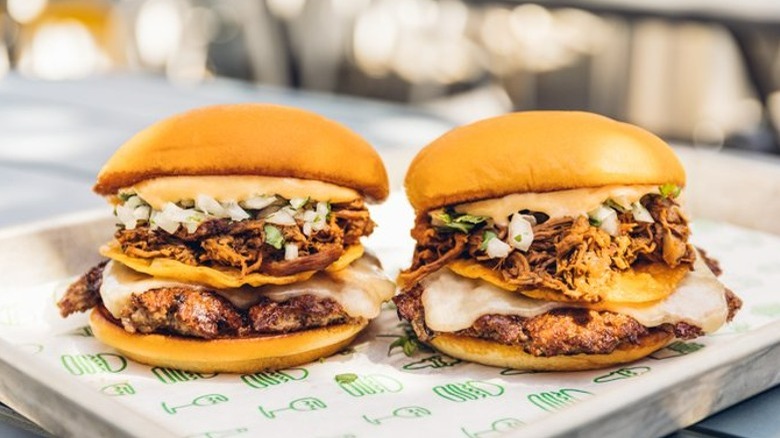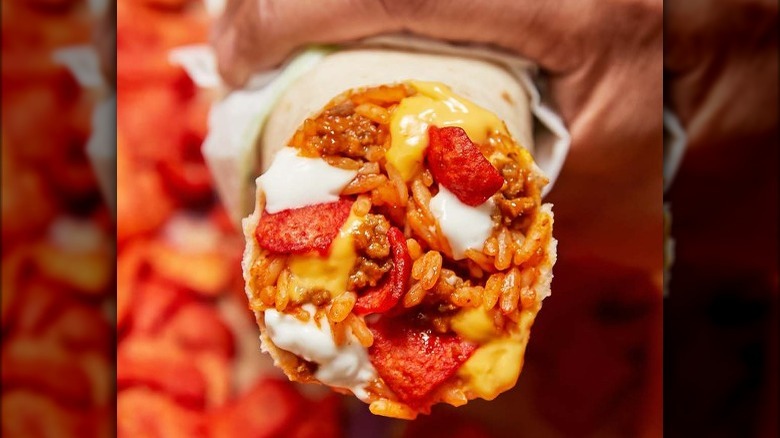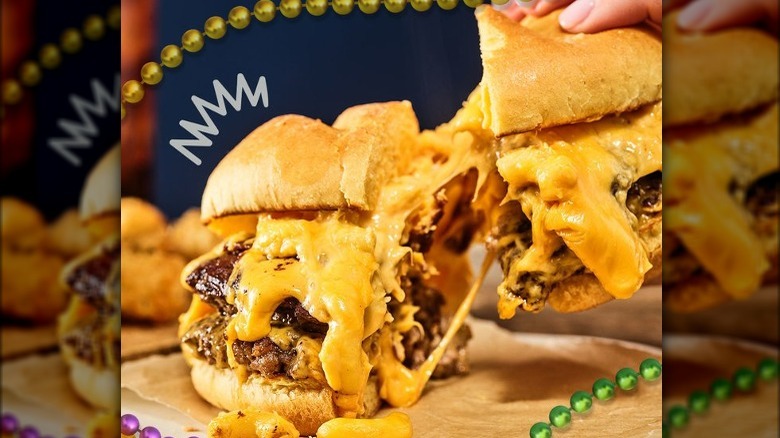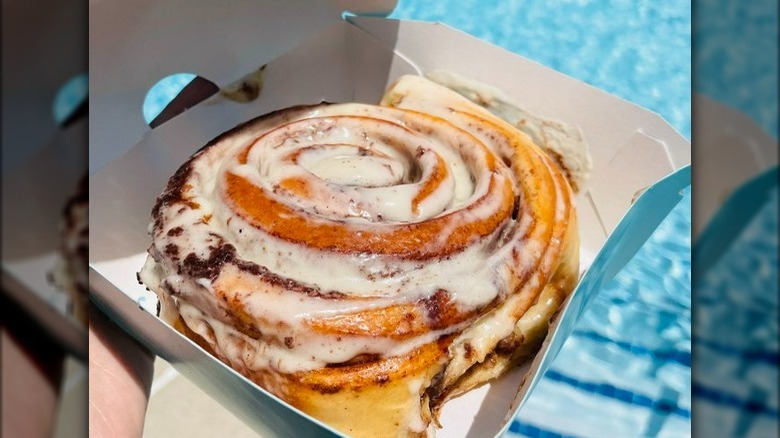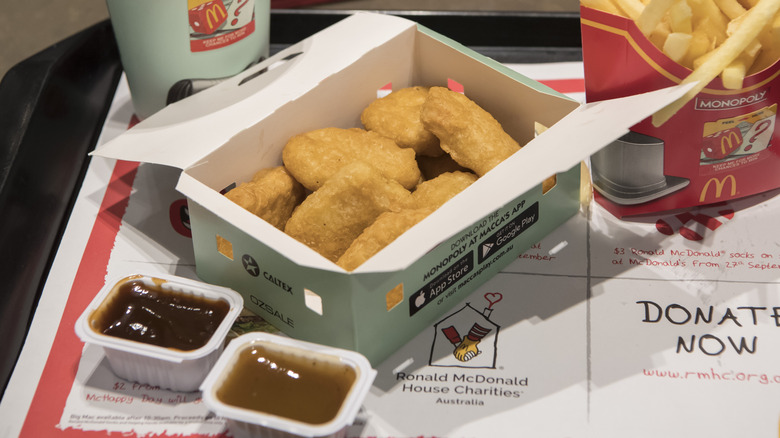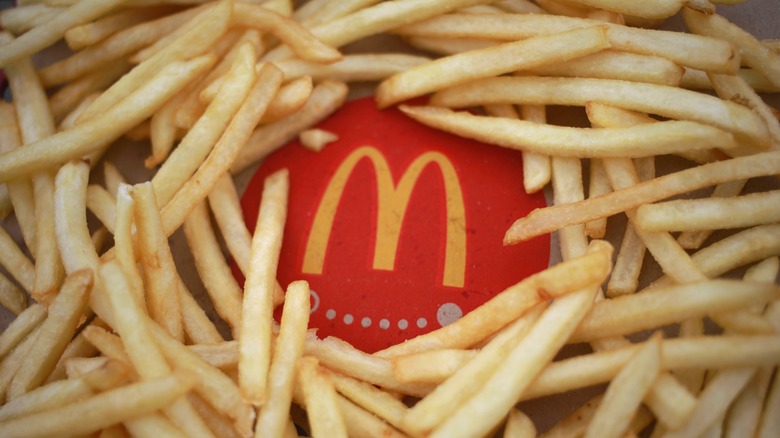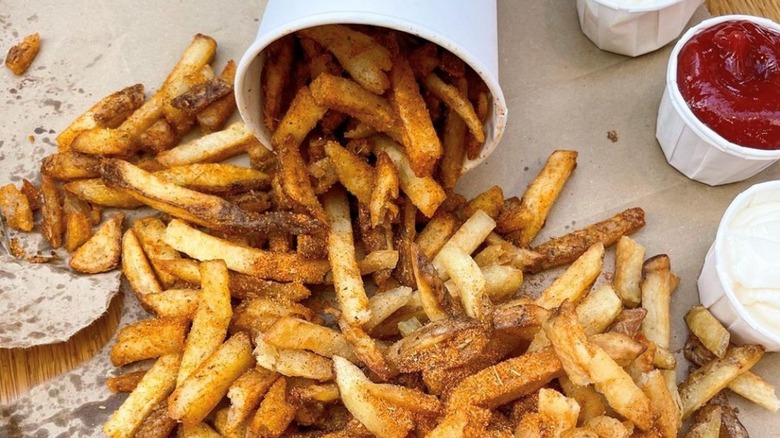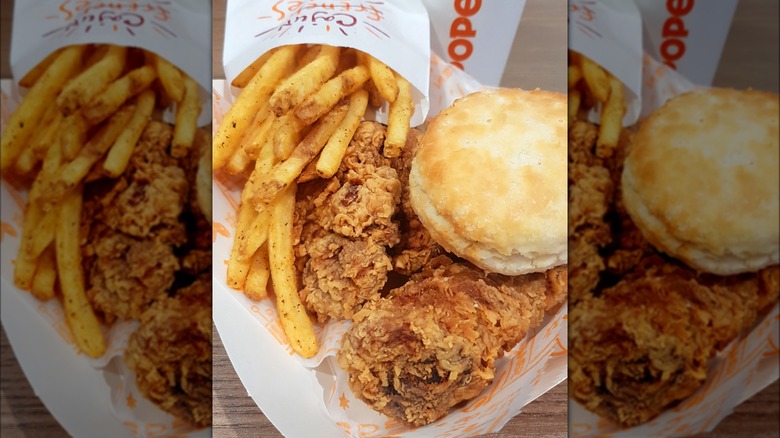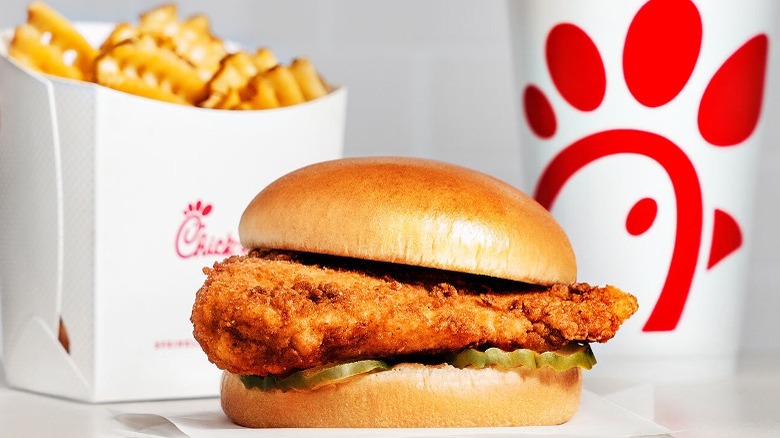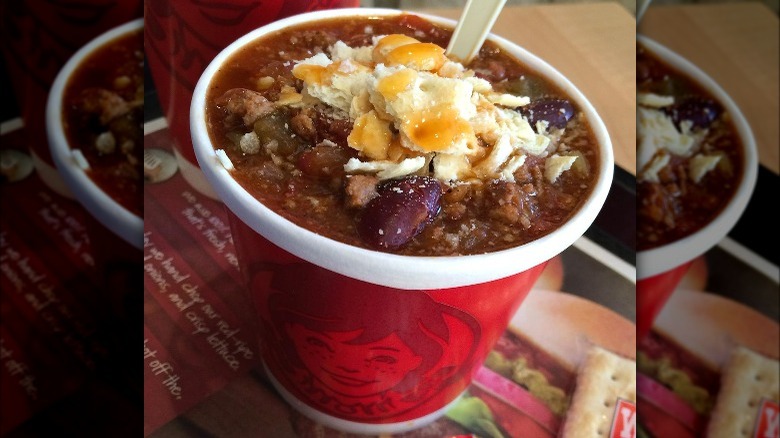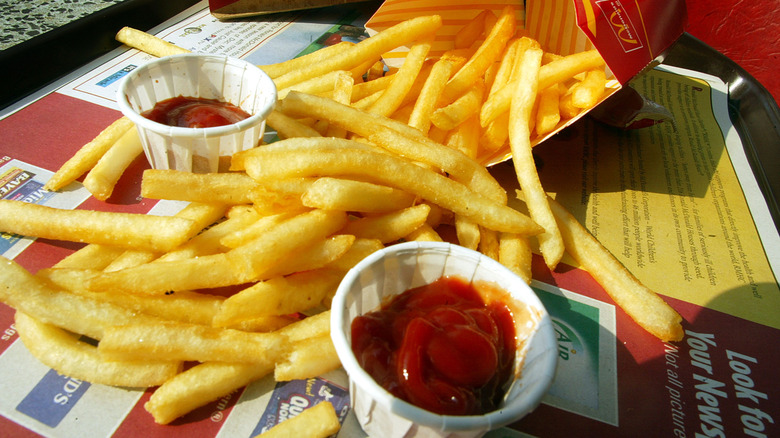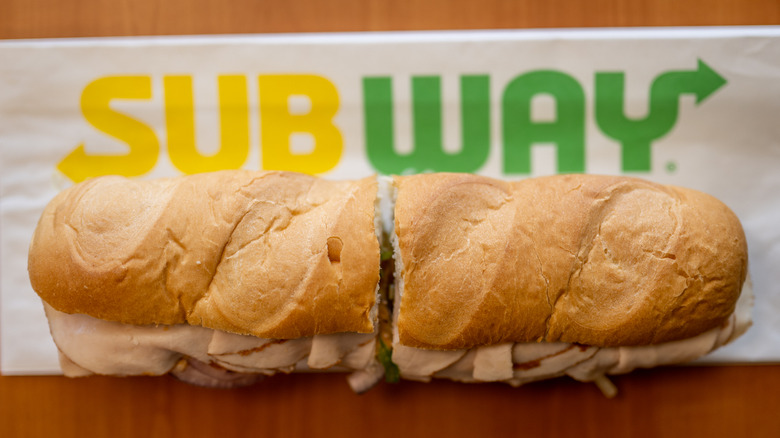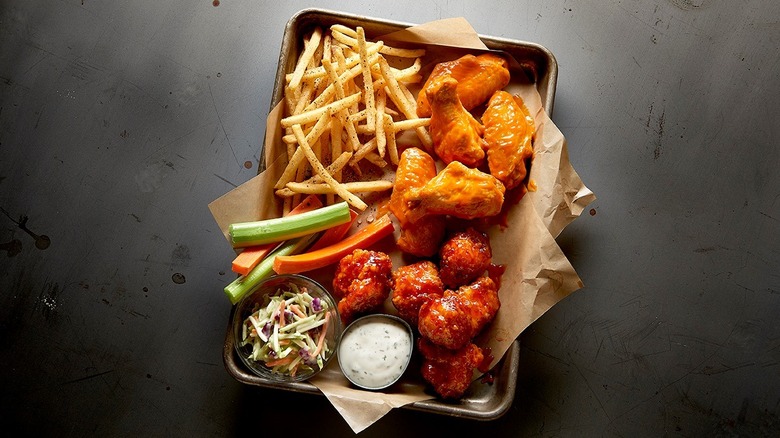Ingredients Fast Food Restaurants Use To Make Their Food Taste Better
Fast food may not have the prestige of a fine dining restaurant, but there's a good reason why these chains have been able to grow into nationwide or even global success stories. Beyond being convenient and affordable, not to mention available for when you just need a quick and easy meal, the food also tastes pretty good. Sometimes, in fact, it tastes surprisingly good.
That's no easy feat for a fast food restaurant, where success hinges on being able to whip up a combo meal in minutes while ensuring that it tastes the same every single time in every single franchise location. So, what are the secrets to consistent and delicious food? In many cases, it's adding quantities of salt and sugar that will make your doctor cry. But sometimes, there's a little something extra that you wouldn't expect — like chicken skin or beef extract. Here are some of the ingredients that our favorite fast food restaurants are using to make their food so irresistible.
Pickle brine in Shake Shack Shack Sauce
According to the "Shake Shack: Recipes and Stories" cookbook, the secret to the franchise's delicious Shack Sauce is pickle brine. It may sound odd at first but pickle brine is kind of a delicacy. Some folks even drink the stuff straight from the jar for the tangy flavor and the purported boost of probiotics and electrolytes in each glug.
It makes sense to add pickle juice to a burger. The acidity of the brine adds brightness to balance out the creamy mayo that's also in the sauce. Meanwhile, the brine's sugar and salt enhance the sweet and savory elements in the sauce's mayo, ketchup, and mustard.
If you want to recreate this sauce at home, first head to the cold section of your grocery store for your pickles. Those are generally "quick pickles" that haven't been fermented in a salty brine. Instead, they were jarred in vinegar to mimic the tanginess and texture of a fermented cucumber. Both taste great, but if you want all of the flavors of pickle brine in your copycat Shack Sauce, you'll want a true brine. The cold section — often near the deli meats — is where many stores stock their selection of genuine fermented pickles. That's where you'll find the brine you need for this sauce.
Yeast in Taco Bell seasoned beef
If you recall the 88% beef scandal that shook this franchise's reputation a few years back, you know there's a little more than beef in what you get at Taco Bell. After a class action lawsuit accused Taco Bell of misleading customers by not disclosing that its beef isn't pure beef, the fast food franchise was forced to disclose the other 12% of ingredients in the mix.
Most of those were usual suspects like spices and water. But, as a Taco Bell representative told the Los Angeles Times, it also includes torula yeast. This is added both to help emulsify the water and oils in the meat mixture and to add a savory taste. The added savory dimension might be there to make up for the loss of beefy flavor incurred by using oats, water, and other ingredients to enhance the texture of the meat mixture.
It's also likely what gives Taco Bell's seasoned beef a distinctive flavor that you might struggle to achieve if you're trying to recreate the discontinued quesarito at home. Next time you try, sprinkle in a little of that torula yeast to more closely match the franchise's seasoned beef.
Roasted chicken skin in Smashburger burgers
In an interview with Franchise Times, Smashburger CEO Tom Ryan explained that the secret ingredient that makes a Smashburger so special is the restaurant's use of chicken skin. Specifically, Smashburger cooks use triple-roasted chicken skin that's been ground to a powder and then added to the franchise's unique seasoning blend.
Dehydrated chicken skin may sound unappetizing to some diners, but its use makes a lot of sense. Chicken skin is full of fat. This means that, when it's roasted, it crisps up and turns savory in much the same way that a slice of bacon would do. Grinding that up and adding it to a seasoning blend adds a smoky, meaty flavor to a dish that would be hard to get from a more standard seasoning.
If you want to try recreating a Smashburger at home, start by roasting chicken skin until it's extra crispy and crunchy. Let it cool a bit before grinding or chopping it. Mix it into your ground beef along with salt, pepper, and garlic, then make yourself some smashed burgers.
Makara cinnamon in Cinnabon buns
Saying cinnamon is the secret ingredient in a Cinnabon cinnamon roll is a bit like saying cheese is the secret ingredient in a grilled cheese. But, in this case, it's a particular kind of cinnamon: Makara cinnamon.
Makara cinnamon comes from Cinnamomum Cassia, which isn't true cinnamon at all. Instead, it's derived from a species of laurel tree that ends up in many of the bottles of ground cinnamon found in grocery stores. Cassia is prized for offering a more intense (though less complex) flavor.
Cinnabon's trademarked Makara blend dials that intensity up a notch by shipping the cinnamon bark whole. It's only ground right before being sent out to Cinnabon locations across the country. Keeping it whole for as long as possible helps preserve the essential oils inside the bark that deliver that pungent cinnamon punch.
Grinding your own cinnamon from whole sticks won't quite recreate the intensity, however, as those tend to be made from smaller twigs and shoots. These typically have lower concentrations of the oils and compounds found in the bark, according to a 2016 study published in Biomedical Chromatography. Those freshly-ground sticks will taste more intense than the pre-ground stuff, but won't quite compare to the intensity of Cinnabon's trademark blend.
Celery salt in McDonald's chicken McNuggets
Scour the ingredient list for McDonald's Chicken McNuggets and hiding somewhere among the mononitrates, pyrophosphates, and other inscrutable ingredients is the word "spices." McDonald's won't disclose the full list of McNugget spices, but it has revealed that at least one is celery salt.
Celery salt is simply a blend of salt and ground celery seeds. You might know it from its role in Old Bay Seasoning or as part of the Bloody Mary you had at brunch. When added to a dish, it delivers saltiness, of course, but also mild pepper and herbal notes. Those extra flavors are subtle enough to never overpower a dish, but add a hint of something extra that makes a meal stand out.
That's exactly what it's doing in the Chicken McNugget. The use of celery salt adds subtle layers of flavor that awaken different taste receptors on your tongue ... and maybe make you wish you'd opted for the 10-piece instead of the 6-piece.
Beef extract in McDonald's fries
Fast food connoisseurs have long known there's something special about McDonald's fries. While it's hard to go wrong when it comes to deep frying potatoes, there's a little something about a warm batch of McDonald's fries that makes us want to shovel them into our mouths by the handful. It turns out that special something is beef extract.
The story starts in the 1950s when McDonald's switched from plain vegetable oil to a mixture of vegetable oil and beef fat. Supposedly, the blend was eventually 93% beef fat and a mere 7% vegetable oil. This led to a crisper exterior that contrasted better with the fluffy potato interior. It also added a hint of beefy flavor that took the fries to a new level.
But when a crusade against saturated fat swept the nation over the next few decades, the fast food franchise caved to public pressure. In 1990, it ditched beef fat. It now adds beef extract to its vegetable oil to make up for some of the lost flavor that gave McDonald's fries their signature taste. Still, some older customers swear the original beef fat version was even better than what's being served today.
Peanut oil in Five Guys French fries
For McDonald's fries, the secret is beef extract. For Five Guys fries, it's all about the peanut oil. While the franchise takes pride in carefully curating and preparing every single ingredient that goes into its fries, it's the peanut oil that it says sets Five Guys apart.
Peanut oil is high in saturated fats compared to the standard vegetable oils used for frying. This makes it a prime choice for deep frying but also allows it to deliver similar results to beef fat — sans the hint of beefy flavor.
It's more than just using peanut oil, however. Five Guys only uses it for fries, meaning the flavor is never affected by other deep-fried ingredients going into the same fryer. Moreover, cooks regularly filter and change the peanut oil to ensure it's as fresh as possible for every batch of fries. The result is a softer, fluffier, and all-around fresher-tasting fry.
MSG in Popeyes fried chicken
Popeyes fried chicken is juicy with a perfectly crunchy breading that's earned the fast food franchise a loyal customer base, though it's admittedly not the cheapest fast chicken in the game. One ingredient that makes its chicken extra special is MSG.
Monosodium glutamate, also known as MSG, is a food additive that's used to enhance flavor. Like salt, MSG contains sodium. The key difference is that the sodium in MSG comes from glutamic acid, an amino acid that lends it a savory, umami edge. When it's added to an already savory dish, it can boost that flavor, making beef taste beefier or, in Popeye's case, chicken taste chicken-ier.
Unfortunately, MSG got a bad rap thanks to overblown claims that it caused headaches and other health effects that aren't supported by research, as per a 2016 review published in The Journal of Headache and Pain. Even so, public pressure caused the fast food restaurant to announce sweeping changes to the ingredients it uses, including ditching the MSG. Popeyes aims to stop using it by 2025.
MSG is also the secret to Chick-fil-A chicken
Popeyes isn't the only fast food chain dosing its fried chicken with MSG. Chick-fil-A also adds a savory flavor enhancer to its fried chicken. It's used in every chicken item on the menu, from the sandwiches to the nuggets, and helps make each one that much more flavorful and satisfying. Unlike Popeyes, Chick-fil-A doesn't seem to have any plans to get rid of the ingredient. If the post-MSG Popeyes chicken doesn't do it for you, consider defecting to the Chick-fil-A camp when the day comes.
If you're concerned about MSG, you probably shouldn't be. Most of the worries that swirled about the ingredient have since been debunked, according to Cleveland Clinic. Consider that MSG is a naturally-occurring substance found in plenty of foods, like cheese and tomatoes.
In fact, it may be a healthier alternative to table salt, at least for people who need to cut their sodium intake. Standard table salt contains 40% sodium (the other 60% is chloride), as per the Centers for Disease Control and Prevention. Meanwhile, a study published in Nutrients found that MSG contains just 12% sodium.
Vanilla in Wendy's chocolate Frosty
A Frosty from Wendy's is one of the best desserts you can get at a fast food restaurant. It's part ice cream and part malty milkshake, a treat that's thicker and creamier than a standard milkshake but as drinkable and refreshing as one. It's been on the menu from day one and continues to be one of the fast food restaurant's most popular items.
The ingredient that sets the chocolate Frosty apart from any other chocolate milkshake isn't just the ice cream, though. It's a dash of vanilla. Since chocolate is often a rich and distinct flavor, it can get overpowering when you're trying to sip a Frosty alongside a cheeseburger or basket of fries. Mixing in a bit of vanilla helps to lighten up that chocolatey flavor just enough that you can pair the shake with a Wendy's combo but still get your chocolate fix.
Sugar in Wendy's chili
You won't just find sugar in your Frosty when you order at Wendy's. The fast food restaurant also sprinkles this ingredient into one of its other popular menu items: chili con carne. According to Wendy's, its chili is a warm, hearty stew that includes beef, tomatoes, kidney beans, peppers — and sugar. While you'll find other standard chili ingredients like dried chilies on the list, it's sugar that takes the fast food chili to a new level.
The sweetness here helps to balance out the acidity and tartness of tomatoes and bell peppers, as well as the savory elements in the chili. If you're trying to make a copycat version, however, go light on the sugar. It doesn't take much to achieve that flavor profile and too much sugar can quickly make your chili too sweet. Sprinkle it into the pot a bit at a time and taste regularly until it reminds you of the Wendy's version.
Water in McDonald's ketchup
Water may not seem like a particularly special secret ingredient, but it's doing a lot more than just thinning out the condiment. It also makes the ketchup taste sweeter and milder, helping it to play off the salty and savory elements of your meal without overpowering anything.
This works because water helps cut through the acidity of the tomato paste that forms the base of a ketchup recipe. When tomatoes are processed and reduced into a concentrated paste, their natural sweetness gets overpowered by the fruit's acidity. If you've ever tried a spoonful of pure tomato paste, you've probably noticed just that. And if you've ever made a tomato-based sauce from scratch, you might know that one of the most widely-used tricks for cutting that acidity is to add water. It dilutes the sauce enough to mellow out that acidity and allow its other dimensions to shine, all without adding any competing flavor.
If you want the flavor of ketchup but you don't want it to steal the show from your burger, McDonald's ketchup is the one to get. If you prefer a punch of tanginess and spice, opt for a thicker fancy ketchup.
Sugar in Subway Bread
Sandwiches and bread are synonymous, but what about making a sandwich out of cake? According to Ireland's Supreme Court, that is pretty much what happens at Subway. In 2020, the court ruled that the chain's bread could not legally be classified as bread due to its higher-than-normal sugar content. Ireland's Value-Added Tax Act limits the acceptable ratio of sugar to flour in bread for tax purposes. Since Subway bread exceeds those set proportions, it is classified as being more like cake or other sweet baked goods than a loaf of bread.
Unsurprisingly, Twitter had plenty of jokes to offer about this ruling. One user tweeted that the chain's sandwiches should be called "Cakes with Ham in Them," and other users ran with this description in the comments section. Multiple studies have suggested that sugar possesses addictive qualities (per Healthline), so it wouldn't be surprising if the additional sugar content went a long way in making Subway sandwiches so tasty.
Beef tallow in Buffalo Wild Wings fried foods
The Buffalo Wild Wings menu is loaded with fried food, and most of these dishes have one thing in common: beef tallow. This substance is made of beef fat and has a consistency resembling lard or vegetable shortening. According to the chain's Allergen & Preparation Guide, Buffalo Wild Wings fries everything from mozzarella sticks to french fries in tallow, which adds richness due to its high saturated fat content and umami taste. The restaurant also fries its signature chicken wings in this substance and even uses it to prepare a fried ice cream dessert.
Although this cooking choice might make the food tastier, it almost got Buffalo Wild Wings into legal trouble. In 2016, the chain faced a class-action lawsuit from vegetarians claiming the company should have disclosed its use of beef tallow. In the end, a judge dismissed the complaint because the plaintiff didn't sufficiently prove how this lack of transparency impacted them.

